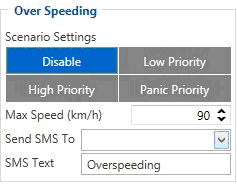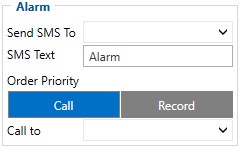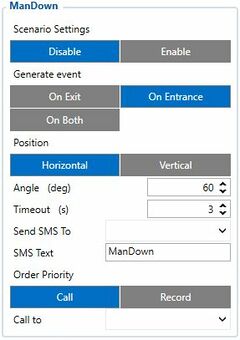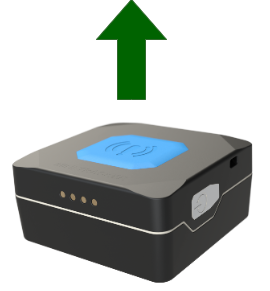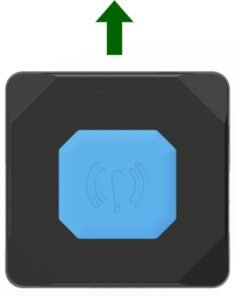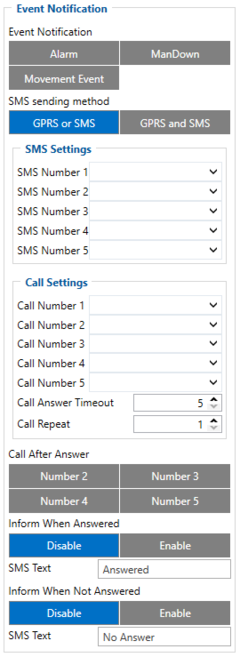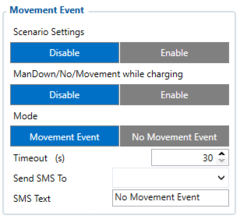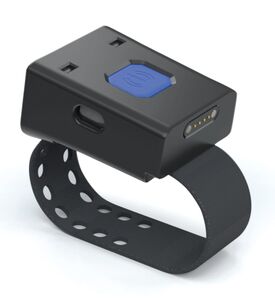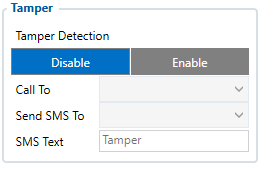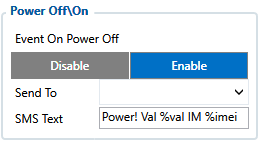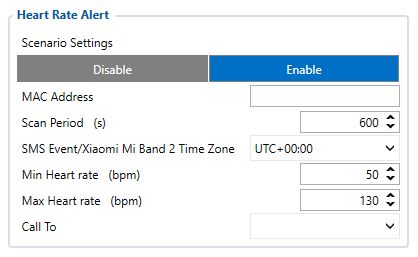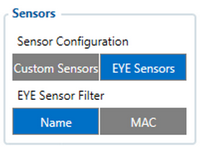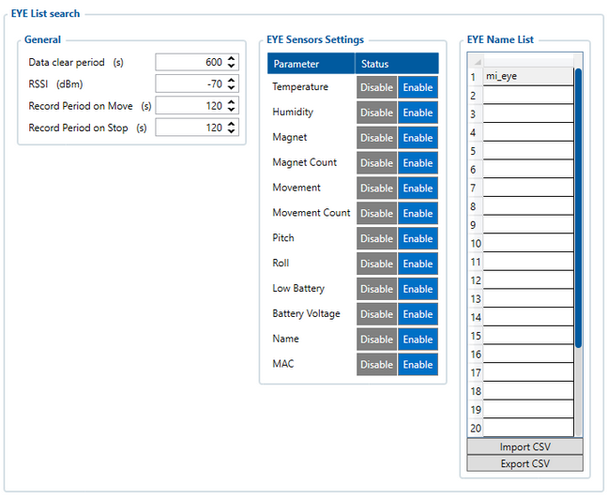Difference between revisions of "TMT250 Features settings"
(added data clear period) |
m (Text replacement - "Bluetooth(?!®)" to "Bluetooth®") |
||
| (10 intermediate revisions by one other user not shown) | |||
| Line 143: | Line 143: | ||
|} | |} | ||
|} | |} | ||
| + | |} | ||
| + | |||
| + | == Shutdown command == | ||
| + | {| | ||
| + | | | ||
| + | *shutdown – SMS/GPRS command, used to shutdown device. Device should respond with “Shutdown has been initiated” an turn off in 15 s after receiving command. | ||
| + | |||
| + | |||
| + | After shutdown device should be able to turn on by pressing powerkey, or connecting charger.[[File:Pav3.png|center|thumb|374x374px|link=https://wiki.teltonika-gps.com/view/File:Pav3.png]] | ||
|} | |} | ||
{| style="width: 100%;" | {| style="width: 100%;" | ||
| Line 149: | Line 158: | ||
== EYE Sensors filtered by Name List == | == EYE Sensors filtered by Name List == | ||
| − | This feature scans for | + | This feature scans for Bluetooth® EYE sensors and checks each sensor’s name (up to the first 10 characters) defined in “EYE Name List”. An exact name match isn’t required, the match is consideted based on the beginning of their names. If a sensor’s name partially or fully aligns with a name on the list, the sensor’s data is stored in record (AVL ID: 11317). In cases where multiple sensors have matching names, data from all these sensors are stored into the record. |
[[File:Pav1.png|center|thumb]] | [[File:Pav1.png|center|thumb]] | ||
| − | + | In order to filter EYE Sensors by their complete local name and create EYE Sensor records (AVL ID: 11317), in Bluetooth® 4.0 tab, Sensors group EYE Sensors and Name has to be selected. | |
| − | |||
| − | |||
| − | |||
| − | |||
| − | |||
| − | |||
| − | |||
| − | |||
| − | |||
| − | |||
| − | |||
| − | |||
| − | |||
| − | |||
| − | |||
| − | |||
| − | |||
| − | |||
| − | |||
| − | |||
| − | |||
| − | |||
| − | |||
| − | |||
| − | |||
| − | |||
| − | |||
| − | |||
| − | |||
| − | |||
| − | |||
| − | |||
| − | |||
| − | In order to filter EYE Sensors by their complete local name and create EYE Sensor records (AVL ID: 11317), in | ||
{| class="wikitable" style="border-style: solid; border-width: 0px;" | {| class="wikitable" style="border-style: solid; border-width: 0px;" | ||
| style="width: auto; text-align: left; background: #0054A6;color:white;" |'''NOTE!''' | | style="width: auto; text-align: left; background: #0054A6;color:white;" |'''NOTE!''' | ||
| Line 197: | Line 172: | ||
<br> | <br> | ||
| + | |||
| + | [[Category:TMT250 Configuration]] | ||
| + | |} | ||
| + | {| style="width: 100%;" | ||
| + | | | ||
| + | == RSSI == | ||
| + | This parameter defines which EYE Sensors add to EYE Sensor List, according to their current RSSI value. If captured EYE Sensor RSSI value is lower than configured RSSI parameter, sensor will not be added to the list. If sensor already has been added to the list and its RSSI value drops below configured threshold, then such sensor’s values will not be updated anymore and if such sensor’s RSSI value will not come back to acceptable range, it will be removed from EYE Sensor List after Data Clear Period. If Data Clear Period is set to 0, sensor will not be removed, when its RSSI value drop below configured threshold. | ||
| + | |||
| + | <br> | ||
| + | |||
| + | [[Category:TMT250 Configuration]] | ||
| + | |} | ||
| + | {| style="width: 100%;" | ||
| + | | | ||
| + | == Record Period parameters == | ||
| + | These parameters define how often to send EYE Sensor data to the server, when FMB is operating in On Stop or On Move modes. EYE Sensors do not have a feature to send their data using On Change mode. Records will be sent only periodically. | ||
| + | |||
| + | <br> | ||
| + | |||
| + | [[Category:TMT250 Configuration]] | ||
| + | |} | ||
| + | {| style="width: 100%;" | ||
| + | | | ||
| + | == EYE Sensor Settings == | ||
| + | This parameter defines what sensor data to add to periodic EYE Sensor records. Sensor can broadcast up to 9 different sensor parameters. In order to reduce record size and traffic, feature has been added to Enable/Disable such parameters from being added to the record if some of parameters are not needed. | ||
| + | |||
| + | <br> | ||
| + | |||
| + | [[Category:TMT250 Configuration]] | ||
| + | |} | ||
| + | {| style="width: 100%;" | ||
| + | | | ||
| + | == EYE Name List == | ||
| + | This parameter list defines what EYE Sensors will be added to EYE Sensor List. If captured EYE Sensor’s complete local name matches the one configured in the list, such EYE Sensor will be added to EYE Sensor List. If EYE Name List is empty, then every detected EYE Sensor will be added to EYE Sensor List. Keep in mind EYE Name List is sharing same parameters with EYE Beacon Name List, since these lists are duplicated. | ||
| + | {| class="wikitable" style="border-style: solid; border-width: 0px;" | ||
| + | | style="width: auto; text-align: left; background: #0054A6;color:white;" |'''NOTE!''' | ||
| + | | style="width: auto; text-align: left; border: 1px solid #0054A6; border-bottom: 1px solid #0054A6; background: white;" | Not full sensor name has to match parameters in configured EYE Name List. For example, in EYE Name List there is added name EYE_SENSOR and FMB captures EYE Sensors with complete local names EYE_SENSOR1, EYE_SENSOR2, then both EYE Sensors will be added to the list. Only part from the name start has to match configured parameters in EYE Name List. | ||
| + | |} | ||
| + | If EYE Sensor has a name that matches configured one in EYE Name List and if it has a MAC address, that matches configured one in EYE Sensors filtered by MAC address, then such sensor will not be added to EYE Sensor list, but it’s data will be added to according EYE Sensor filtered by MAC IO elements. | ||
| + | |||
| + | <br> | ||
| + | |||
| + | [[Category:TMT250 Configuration]] | ||
| + | |} | ||
| + | {| style="width: 100%;" | ||
| + | | | ||
| + | == Record structure == | ||
| + | EYE sensor record stores multiple eye sensors data that match with names in eye sensor name list. | ||
| + | |||
| + | <br> | ||
| + | |||
| + | [[Category:TMT250 Configuration]] | ||
| + | |} | ||
{| class="wikitable" | {| class="wikitable" | ||
|+ | |+ | ||
| − | |||
!Name | !Name | ||
!Data type | !Data type | ||
| − | |||
| − | |||
| − | |||
!Description | !Description | ||
|- | |- | ||
| − | | | + | |Length |
| − | | | + | |Uint8_t |
| − | | | + | |Reserved. Added to each EYE Sensor start. Currently always 0. |
| − | |0 | + | |- |
| − | | | + | |Device Name |
| − | | | + | |Array |
| − | | | + | |Device’s name from Device Name List tab |
| − | | | + | |- |
| − | + | |Temperature | |
| − | + | |Int16_t | |
| − | + | |Temperature value measured by EYE Sensor from List. Values from -32768 to +32768 with 0.01 C delta | |
| + | |- | ||
| + | |Humidity | ||
| + | |Uint8_t | ||
| + | |Humidity measured by EYE Sensor from List. Values from 0 to 100% | ||
| + | |- | ||
| + | |Magnet | ||
| + | |Uint8_t | ||
| + | |Magnet measured by EYE Sensor from List. Values from 0 to1 | ||
| + | |- | ||
| + | |Movement | ||
| + | |Uint8_t | ||
| + | |Movement measured by EYE Sensor from List | ||
| + | |- | ||
| + | |Movement count | ||
| + | |Uint16_t | ||
| + | |Movement counts measured by EYE Sensor from List | ||
| + | |- | ||
| + | |Angle Pitch | ||
| + | |Int8_t | ||
| + | |Pitch Angle measured by EYE Sensor from List | ||
| + | |- | ||
| + | |Angle Roll | ||
| + | |Int16_t | ||
| + | |Roll Angle measured by EYE Sensor from List | ||
| + | |- | ||
| + | |Low Battery State | ||
| + | |Uint8_t | ||
| + | |Low battery state measured by EYE Sensor from List | ||
| + | |- | ||
| + | |Battery Voltage | ||
| + | |Uint16_t | ||
| + | |Battery voltage measured by EYE Sensor from List | ||
| + | |- | ||
| + | |MAC address | ||
| + | |Uint8_t array | ||
| + | |Device’s MAC address | ||
| + | |- | ||
| + | |Magnet Trigger count | ||
| + | |Uint16_t | ||
| + | |Magnetic sensor trigger counts measured by EYE Sensor from List | ||
|} | |} | ||
|} | |} | ||
Latest revision as of 15:26, 28 December 2023
Main Page > Autonomous Trackers > TMT250 > TMT250 Configuration > TMT250 Features settingsOver Speeding
|
This feature is used to prevent the driver from exceeding fixed speed and inspects the driver if needed. When vehicle speed exceeds maximum configured speed value the scenario is activated, and a record is generated. Scenario is activated until speed value decreases below the set parameter value. |
Alarm
|
This function can only be triggered by the configured button. When the alarm is triggered, an event with IO ID 236 is generated. Eventually an SMS will be sent informing user about the event. A call possibility is also available if desired number is selected near Call to parameter. In addition, users are allowed to configure event priority. Two options are available - Call where voice call comes first and Record where data transmission to servers will be prioritized over a voice call. |
ManDown
|
This feature gets current accelerometer data and calculates angle between offset positions. Currently there are two positions: horizontal (when device is in horizontal position and alarm button is on top) and vertical (when device is in vertical position and magnetic USB connector is facing up). Scanning is performed each second. If On-Entrance option is selected, event will be generated once calculated angle exceeds configured threshold for configured timeout. If On-Exit option is selected, event will be generated once device exits ManDown scenario. If On-Both is selected, event will be generated both times. SMS event and/or call takes place, if it is configured.
|
Event Notification
The purpose of this function is to notify any alarm events by sending an SMS message to up to 5 receivers and to call up to 5 pre-defined numbers.
These high priority events can be configured:
- Alarm;
- ManDown;
- Movement Event.
At least one of the following has to be selected for this feature to work - Alarm, ManDown or Movement Event. In addition, at least one SMS Number or one Call Number has to be configured.
Users are allowed to configure SMS sending method. Two options are available - GPRS or SMS option which sends an SMS when GPRS fails and GPRS and SMS option which sends an SMS when GPRS fails or device sends records to the server.
Call Answer Timeout is used for indicating successful call - if voice call was answered but configured time-out has not been reached, the voice call is considered unsuccessful and if only one number is configured, the device repeats the call as many times as the value configured in Call Repeat field. However, if the call is not successful and there are other predefined numbers selected, the device continues to call other configured numbers instead of repeating voice calls to the same number.
| NOTE! | Some operators provide voice information when the recipient is unreachable or call is not accepted. Such voice information may last longer than the configured time. In that case, the call will be considered as accepted. |
Movement Event
|
Movement Event scenario makes an eventual high priority record (and sends an optional SMS) when the device is stationary or in motion (depending on configured "Mode") for set Timeout.
Additional Features
Tamper
Power Off/On
|
Shutdown command
|
EYE Sensors filtered by Name ListThis feature scans for Bluetooth® EYE sensors and checks each sensor’s name (up to the first 10 characters) defined in “EYE Name List”. An exact name match isn’t required, the match is consideted based on the beginning of their names. If a sensor’s name partially or fully aligns with a name on the list, the sensor’s data is stored in record (AVL ID: 11317). In cases where multiple sensors have matching names, data from all these sensors are stored into the record. In order to filter EYE Sensors by their complete local name and create EYE Sensor records (AVL ID: 11317), in Bluetooth® 4.0 tab, Sensors group EYE Sensors and Name has to be selected.
|
